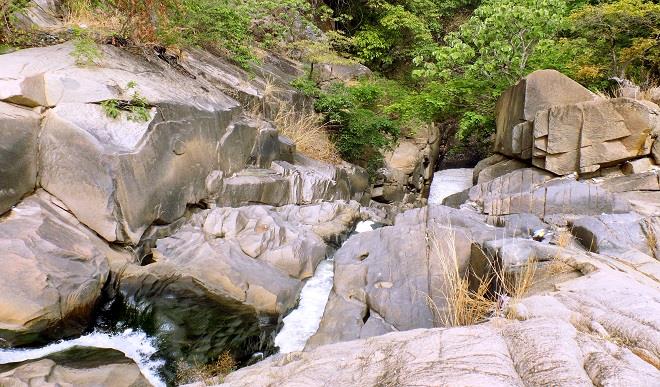
From the Palace of the Sarkin Zazzau (Suleja), just about a mile will take you to the Mayanka Falls on the outskirts of the town; but just a few residents know this historical location or its two hundred years of existence in the capacity which gave it its fearful name: Mayanka.
The ‘infamy’ and the ‘fearfulness,’ and, thus, the interesting part of the tale about the location, seem all more about the ‘Mayanka’ than about the ‘falls,’ whatever attraction the falls may exude to any modern-day tourist.
The Ward Head of Kofar Boye (the hidden gate), Mai’anguwa Garba Sa’idu, a master of the terrain, gave us a ride on his rickety Suzuki motorcycle on the rocky narrow path up and down sections of the hilly terrain, sometimes advising me to alight to enable him take a survey down from uphill, through the shrubs and rock-laced terrain to figure out any strip of space that looked like a path, for us to maneuver in the right direction to the valley.
At a point, Mai’anguwa (Ward Head) had to park his Suzuki uphill. We trekked on the rocks, treading with utmost care downwards towards the falls, sweating under the scorching tropical heat of April.
We were on the rocks for about 20 minutes.
Since my two-hour ascent to the Rock Palace of the Xidi Sakun right at the peak of the Ngwa Sakun (Sukur Mountain) in Madagali Local Government Area of Adamawa State in 2008, I have not embarked on such journey.
At last! We arrived the falls by 10:30 am.
Standing right on the cliff, the most infamous and dreadful point of the Mayanka, gasping for breath, we surveyed the valley and River Iku, from the gushing foamy water of the falls gravitating down with the force of its history, far to the distant hills into which the river disappeared.
The environment of the Mayanka was still wrapped up in its horrific quietude, its infamy frozen in its two centuries of history.
Mayanka is the Hausa name for slaughter house, slaughter slab or any slaughter location, usually for the slaughtering of animals for human consumption.
Suleja’s Mayanka, down the falls of River Iku, was the location for the slaughtering (execution) of criminals sentenced to death by the traditional authorities of the domain in the pre-colonial times.
As part of its comprehensive system of administration, every Nigerian community from time immemorial up to the advent of colonialism, had its system of administering justice with regard to what it conceived as civil and criminal offences according to its traditional norms and values.
Consequently, the community had spelt out punishment for every offence or crime, from the payment of a paltry fine to death sentence as maximum capital punishment. The community had its own method of executing whoever was sentenced to death.
In Hausa land of Northern Nigeria, for example, every community had a Hauni (executioner), whose sole duty it was to execute whoever was sentenced to death by the royal court of the Sarki (King). Such executions took the form of the Hauni complete decapitation of the criminal with his sword. This method, according to oral tradition, seemed to be the most common.
Other methods, such traditions hold, included simply slaughtering the condemned criminal, as done on any animal prepared for human consumption, or driving a sharp stick through the person, leaving him or her in severe pain to agonize to death.
Such executions usually took place before a large crowd at the market place, any place marked for the purpose, or as directed by the royal court.
In the domain of Zazzau (Suleja) in those days, the location marked for that purpose was the valley down the Falls of River Iku, where the condemned criminal would be dragged for the slaughter (yanka) by the Hauni, in the presence of a group of Dogarai (palace guards). Hence, the location was named: Mayanka (slaughter or execution location).
Crimes punishable with death included murder and, according to sources, being a Fulani man or woman. The Galadiman Zazzau (Suleja), the traditional historian of the domain, Alhaji Mohammad Rabi’u Is’haq, simply described the Fulani people as arch enemies of the domain in those days.
Why were the Fulani people ‘criminals’ in the domain of Zazzau (Suleja) in those days?
The 19th Century Shehu Uthman Danfodio-led jihadists sacked the Zage-zagi from their ancestral domain (headquartered in Zaria) from where they journeyed southwards to the present location to found another domain of Zazzau.
Hence, according to the source, every Fulani man or woman sighted in the domain in those days would be regarded as a spy for the jihadists and would, therefore, be arrested and dragged before the royal court of the Sarkin Zazzau as a criminal, to be summarily sentenced to death by the sword of the Hauni at the Mayanka.
“All I can tell you is that the Fulani were the arch enemies of the domain during the time of our ancestors, and they did not even dare to enter the domain; the jihadists never conquered us. Those who executed the jihad in the ancestral land of Zazzau from where our ancestors were forced to migrate, deceived the Shehu that the Zage-zagi were heathens. They told a blatant lie to the Shehu.
“The Shehu, who never knew that it was a domain of Muslims, and that some people in Zaria then even spent seven years to and from the pilgrimage in Mecca, gave them the flag to execute the jihad against Zaria,” the Galadima stressed.
It was said that the Jihadists attacked Zaria on the day of the Muslim Festival of Sacrifice (Eid-el-kabir or Babbar Sallah) when the Zage-zagi had to disarm at home and go to the Eid ground to observe the prayer.
The Zage-zagi were said to be battle-ready with their arms every time, wherever they were. So, if they had received intelligence reports that they would be attacked at the prayer ground, they would not have left their arms at home, and they would not have been forced to flee their ancestral home.
According to history, this ‘breach of trust’ by the Fulani against the Zage-zagi, their fellow Muslims, could be the sole reason that incriminated the Fulani to the Zage-zagi of Suleja.
The Mayanka was first used as such by Abubakar Jatau (abbreviated to Abu-Ja, from which the present Federal Capital City derived its name: Abuja), the 62nd Habe King of Zazzau and the 1st King of the domain. He reigned from 1825 AD to 1851 AD.
The domain was, consequently, named after him: Abu-Ja (which adopted the name: ‘Suleja’ after the establishment of the Federal Capital City).
According to Galadima Mohammadu, at the Mayanka, before the Hauni beheaded a criminal, or hit him or her with a club, his or her right hand would first be cut off and taken to the Sarkin Zazzau at the palace to convince him that the sentence had been carried out. The Hauni would then cut off the head of the criminal or hit him or her with a club, and then hurl the remains down the cliff into the valley, to be swept by the force of the gushing water of the falls to wherever it could carry it.
In some communities, the Hauni would carry the head of the criminal to the King to show that he had executed the sentence dutifully and truthfully, especially where the execution was not carried out before a crowd.
“I am now 42 years old, and I have never heard about any execution carried out there,” Mai-anguwa Garba said about the last time any such capital punishment was carried out at the Mayanka.
“But I will stress it to you that in the recent past, I can even say that the location used to be horrifying because it was full of evil forces, and whoever attempted to cross the valley any moment from the late afternoon, some forces would lift him and cast him ferociously far away. It was unheard-of that any human crossed that valley,” he said.
“Whoever was so lucky to cross there would get lost in the forest, and it would require exceptional efforts and prayers to get him rescued, because he would be possessed ” the Ward Head said.
“There existed a huge mermaid which was said to appear once every year at the location in the past,” he said, adding, “a lot of our ancestors, who were said to have marked its time of appearance, always went to the location to perform some rituals to this creature for some worldly achievements, and they were said to have succeeded in the rituals when they met it.”
According to him, “European tourists frequent the location and to ease their descent to the falls a flight of stairs was constructed for them down the hill. You may have heard that Sarki Sulaimanu was a very good friend of the Europeans (colonialists).
To preserve the history of the Mayanka Falls, the Palace especially under Emir Mallam Muhammad Awwal Ibrahim, has ensured the maintenance of a road leading there, as well as the prohibition of any activity that could tamper with the originality of the environment.
In terms of the purpose it served in the olden days, Mayanka has since been rendered defunct by modern legal and judicial systems.




